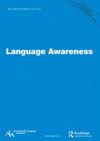汉语学习者如何获得正字法知识:成分、结构和位置规则
IF 2.2
2区 文学
0 LANGUAGE & LINGUISTICS
引用次数: 3
摘要
摘要由于汉语书写系统和母语在拼写特征上的差异,学习汉字对许多CSL学习者来说可能是一项挑战。虽然获得正字法知识对学习汉字可能很重要,但他们如何获得有关汉字正字法不同方面的知识(即成分、结构和位置规律)的研究较少。构件是汉字的一个基本感知构件,汉字结构是构件相对位置形成的构形布局。许多组件在集成形成字符时都应该遵循隐含的位置规则。在本研究中,共有213名香港CSL学生被邀请完成三项任务,测量学生的组成知识、结构知识和位置规律知识。研究发现,CSL学生在这些任务中的整体表现似乎受到性格结构的影响。此外,我们发现成分知识通过结构知识的中介作用对位置规则性知识产生了间接影响,这表明学习者如何在感知观察的基础上逐渐理解复杂的正字法规则可能存在联系。文中还讨论了对汉语教学的启示。本文章由计算机程序翻译,如有差异,请以英文原文为准。
How do Chinese as a second language (CSL) learners acquire orthographic knowledge: component, structure and position regularity
Abstract Learning Chinese characters could be challenging for many CSL learners due to the distinction in orthographic features between the Chinese written system and their first languages. While acquisition of orthographic knowledge could be important for learning Chinese characters, how they can gain knowledge about different aspects of Chinese orthography (i.e. component, structure and position regularity) remains less studied. The component is a basic perceptual constituent of Chinese characters, the character structure is the configuration layout formed by relative positions of components. Many components are supposed to follow the implicit position regularity rule when they are integrated to form characters. In this study, a total of 213 CSL students in Hong Kong were invited to complete three tasks measuring students’ component knowledge, structural knowledge, and position regularity knowledge. It has been found that overall CSL students’ performance in these tasks seemed to be affected by character structures. Furthermore, we found that component knowledge had an indirect effect on position regularity knowledge via the mediation of structural knowledge, which showed a possible link about how learners gradually understand complex orthographic rules based on the perceptual observation. Implications for the teaching and learning of the Chinese language were also discussed.
求助全文
通过发布文献求助,成功后即可免费获取论文全文。
去求助
来源期刊

Language Awareness
Multiple-
CiteScore
3.70
自引率
10.00%
发文量
18
期刊介绍:
Language Awareness encourages and disseminates work which explores the following: the role of explicit knowledge about language in the process of language learning; the role that such explicit knowledge about language plays in language teaching and how such knowledge can best be mediated by teachers; the role of explicit knowledge about language in language use: e.g. sensitivity to bias in language, manipulative aspects of language, literary use of language. It is also a goal of Language Awareness to encourage the establishment of bridges between the language sciences and other disciplines within or outside educational contexts.
 求助内容:
求助内容: 应助结果提醒方式:
应助结果提醒方式:


